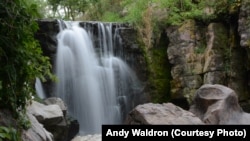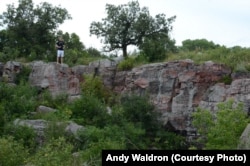In celebration of the National Park Service’s 100th anniversary this year, adventurer Mikah Meyer is traveling across America with the goal of visiting every one of the more than 400 sites within its jurisdiction.
The young traveler set out from Washington, D.C., in June and has already visited dozens of sites. And VOA has been following him every step of the way.
Thanks to the stunning photographs and videos Mikah and his travel companion, Andy Waldron, have been sending us, we have a virtual front-row seat to some of the most amazing landscapes and seascapes within the park system.
Sacred ground
During his travels across the northern states, Mikah has been struck by the extent to which Native American history is part of so many of the park units.
“Which makes sense, because they were all here before we were,” he remarked in a recent conversation with VOA. “They were all over the country and it's a really rich history, both culturally and archaeologically.”
That presence was evident at Pipestone National Monument in southwestern Minnesota, which was established in recognition of the red pipestone that’s prevalent there. The special stone is the main reason the place has been sacred to Native Americans for countless generations, Mikah explained, because they used the stone to make pipes for use in prayer.
“When natives prayed they would use the smoke [from those pipes] to send their prayers up to the heavens.”
It was disturbing for Mikah to learn that when white settlers moved into the area in the late 1800s, the natives were deprived of the materials they needed for their spiritual needs. “As I walked through this place I thought, ‘What if the Kaabah in Mecca was destroyed? What if Westminster Abbey was destroyed? What if the Dome of the Rock was destroyed?'
“For these people, this was their Dome of the Rock,” he said. “And settlers came in and took it over, and I had this immense feeling of how horrible that must have felt for them to have their sacred place run over.”
The good news is that the establishment of the Pipestone National Monument in 1937 allowed Native Americans to resume their tradition of quarrying and pipe-making.
Mikah had an opportunity to watch a park staff member making pipes at the park’s gift shop, and even handle pieces of the special stone himself. He used a modern saw and shaver to whittle the stone, which gave him a chance to feel just how malleable the material was. “It was fun to be able to use it with your own hands … made it a lot more sensory,” he said.
Moundbuilders
Another place that holds special meaning for Native Americans is a national monument in Iowa, associated with the culture known today as the Effigy Moundbuilders. The 200 plus American Indian mounds of earth — commonly in the shapes of birds, bears, deer, bison, lynx, turtles, panthers or water spirits — are located in one of the most picturesque sections of the Upper Mississippi River Valley, the Effigy Mounds National Monument.
While the exact purpose of the mounds remains unclear, stories and legends of the Native Americans whose ancestors built them describe them as ceremonial and sacred sites. Archaeologists believe the effigy mounds delineated territories of choice gathering and hunting grounds.
A visit offers opportunities to contemplate the meaning of the mounds and the people who built them.
Rugged wilderness
The Saint Croix National Scenic Riverway in Minnesota is made up of the St. Croix and Namekagon rivers. Located about 83 kilometers (52 miles) north of the Twin Cities (Minneapolis and Saint Paul), it offers over 320 kilometers (200 miles) of clean water that glides and rushes through a forested landscape.
Mikah got to ride on a riverboat and also went kayaking on the river, which he described as isolated in many parts. “So basically just one hour northeast of a city of 3.5 million people, here’s this place where it's a wild river,” he said.
“There are laws that keep it from even having cellphone towers within sight of the water, because the whole point is to make you feel exactly like you would have before there was human interaction.
“So for people who live in an urban area like the Twin Cities, within an hour they can be somewhere that feels like they are a thousand miles away from civilization.”
Urban beauty
Another stop on Mikah’s summer journey was the Mississippi National River and Recreation Area, a 116-kilometer (72-mile) river corridor through the Minneapolis-Saint Paul metropolitan area.
It was a complete contrast to his previous experience, Mikah said. While the Saint Croix National Scenic Riverway was wild and isolated, “this park is meant to serve an urban community.”
The park follows the course of the Mississippi, past visitor centers, wildlife refuges, state and regional parks, dams, overlooks and historic sites.
And, Mikah noted, a lot of modern America. "It's condos, it's downtown Minneapolis, it's downtown Saint Paul, it's old mills, it's industry, there were barges going through. So I think a lot of this park is not so much about the river as it is the small city and state parks along the river that are interspersed within an urban area that is trying to provide a sense of nature within a city of 3.5 million people.”
Mikah says he’s happy to be spending the week of the National Park Service’s official 100th birthday experiencing places “that don't always get as much attention as other places within the park system.”
“I'm realizing that they’re just as much of a part of the National Park Service as other units.”
Common ground
During his visit to Minnesota, Mikah had a chance to share his park experience with U.S. Representative Betty McCollum, who serves Minnesota's 4th Congressional District and is a member of the House Appropriations Committee.
“We talked about each of our ‘discoveries’ of the national parks, what they've meant to us in the past, and what they mean to us now,” Mikah said.
He noted with interest their mutual interest, but within different capacities. “Here you have someone responsible for helping fund all 412 units, and next to her is someone trying to visit all 412 units.”
Coming attractions
Mikah recently spent a day speaking about his park experience to fourth-grade students at a school in Oregon, Illinois. He will spend a few more days in Illinois before heading to Indiana.
Follow Mikah
To follow Mikah and learn more about the places he’s traveling to, visit him on his website or Facebook page.














